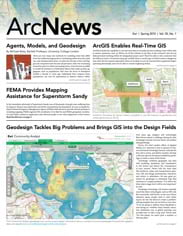Employees with geographic and geospatial skills are in high demand to help solve real-world problems and enhance organizations’ efficiency and effectiveness. The latest estimates from the US Bureau of Labor Statistics classify GIS and remote sensing (RS) as “new and emerging” fields, in part because of their importance to the “green” jobs sectors. Job openings for GIS and RS scientists, technicians, and technologists are projected to grow between three and nine percent between 2010 and 2020, while median salaries for these positions continue to rise. The job category of “geographer” is poised for even more dramatic growth, with job openings projected to increase nearly 30 percent by 2020.
A recent report by the Georgetown Center on Education and the Workforce revealed that geographers are highly dispersed across sectors and industries within the US work force. Therefore, a comprehensive search for geography-related jobs should span resources across the business, government, nonprofit, and educational sectors. The AAG’s Jobs in Geography and GIS Center is an excellent starting point. This online jobs listing allows you to search for current job openings by sector (e.g., private, public, academic, nongovernmental organizations [NGOs], etc.), by state or international location, and by topical specialties.
Other leading industry resources for careers in geospatial technology and GIS include Esri, Directions, GISLounge.com, GISjobs.com, and the GIS Jobs Clearinghouse. Because the public sector continues to be a major employer of geographers, USAJobs.gov is a helpful place to go for federal government employment. Idealist.org is a central repository for volunteer and employment opportunities in the nonprofit and NGO sectors. Links to all these career resources can be found on the AAG careers website.
Research conducted for the AAG’s National Science Foundation-funded EDGE program, which is geared to better preparing graduate students for nonacademic jobs in geography and GIS, indicates that employers today are particularly seeking employees who can apply broad, interdisciplinary perspectives and diverse expertise to the specific needs of their unique organizations and industries. More companies and industries are now using location-based data and spatial analysis to support business operations as wide-ranging as health care delivery, retail sales, environmental management, transportation planning, economic development, and more.
While the employment outlook for geography and GIS careers is relatively strong, competition for openings is high. In a tight job market, many students and professionals are considering strategies to boost their credentials and enhance their portfolio of skills. In addition to opening up new career paths, further education can also lead to increased earning potential. A directory of state-by-state listings of online courses, certificates, and degrees offered in geography and GIS is posted at www.aag.org/education. An important credential for GIS careers is professional certification. Information on becoming a certified GIS Professional (GISP) is available from the GIS Certification Institute, the leading GIS certification organization in the United States.
Volunteering and internships with potential employers also provide excellent work-based learning and professional development opportunities. Many employers recruit from their intern and volunteer pools, so these short-term experiences can often lead to longer-term or permanent employment. AAG has developed guidelines on how to get the most out of your internship and also lists internship and mentoring opportunities at its Jobs Center.
The Association of American Geographers offers a broad selection of resources to help current and aspiring geography and GIS professionals make the most of the many available employment opportunities. The Jobs & Careers area of the AAG website features a range of educational and informational materials to support career exploration, including profiles of geographers working in a variety of fields, salary data and employment trends for more than 90 geography and GIS-related subfields, tip sheets and resumé advice, and much more. Also available is the new book, Practicing Geography, which provides a wealth of information on geography and GIS careers in business, government, and non-profit organizations. To access this regularly updated information, visit www.aag.org/careers.
The AAG’s Annual Meetings (April 9–13 in Los Angeles this year) also feature a robust offering of current job listings, careers panel discussions, drop-in career mentoring services, and professional guidance and networking opportunities for prospective employees at all career stages. Good luck with your next job search!
Doug Richardson
(with contributions by Joy Adams and Jean McKendry)


